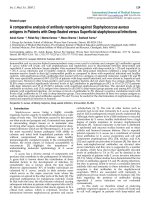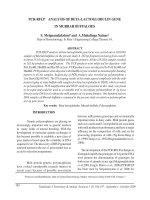Tài liệu A Comparative Analysis of Individual Communication Processes in Small docx
Bạn đang xem bản rút gọn của tài liệu. Xem và tải ngay bản đầy đủ của tài liệu tại đây (123.14 KB, 16 trang )
Proceedings of the 2003 Association for Business Communication Annual Convention
Copyright 2003, Association for Business Communication
A Comparative Analysis of Individual Communication Processes in Small
Group Behavior between Homogeneous and Heterogeneous Groups
Bertha Du-Babcock
Department of English and Communication, City University of Hong Kong
This study compares the communication behaviors (i.e., turn taking and speaking time
distribution) of a cross-cultural small-group communication environment to further
investigate the generalizability of Du-Babcock’s (1999) findings. The study also adapted
Oeztel’s (1998) effective decision-making theoretical model (EDMT) to broaden the
investigation to include cultural dimensions and group composition influences on
communication behaviors in small group meetings. The findings suggest that although
culture is a contributing factor, the influence of culture and group composition on the
communication behaviors of individuals in a homogeneous or in a heterogeneous group
decision-making meeting is mixed.
Introduction
The purpose of this study is twofold. Firstly, my overall objective is to study turn-taking
behavior and further investigate the generalizability of the results of an earlier Hong Kong
investigation (see Du-Babcock, 1999, pp.544-574) by extending the research to a different
geographical location where English is the dominant medium of communication, but where
participants came from diverse cultural backgrounds. The earlier study found that the length
of speaking time among individuals was almost the same in the English and Cantonese
meetings, but differences existed in the number and length of turn-takings: group members
took more and shorter turns in the Cantonese meetings and fewer and longer turns in the
English meetings. Secondly, the current study adapted Oetzel’s (1998) effective decision-
making theory (EDMT) to examine the extent that cultural dimension (individualism-
collectivism or I-C) and group composition (homogeneous-heterogeneous) influence small
group turn-taking behaviors.
The reason for undertaking this research arises from the results of my earlier published
empirical study in turn-takings (see article in Management Communication Quarterly, 1999,
544-574) and a business pilot study on business ethics and communication that found a large
majority of both individuals and groups make decisions emphasizing short-run gains
(increased profits) and make unethical decisions at the expense of compromising both long-
term gains and ethical standards. Taken together, the results from these studies (which focus
on the Hong Kong environment) suggest the need for further and broader investigation of
intercultural small group communication environments. The current study attempted to
integrate the key issues derived from these two earlier studies and further investigate how
1
Proceedings of the 2003 Association for Business Communication Annual Convention
Copyright 2003, Association for Business Communication
cultural I-C and group composition impact small-group behavior in respect of turn-taking
behaviour and speaking time distribution.
The key issues and problems addressed in this current research therefore revolve around the
importance of small group communication behaviors in decision-making meetings among
individuals who came from similar cultural backgrounds (homogeneous groups) and different
cultural backgrounds (heterogeneous groups). It also seeks to identify the extent to which one
dimension of national culture (individualism-collectivism according to Hofstede, 1991, and
Trompenaars, 1993) influences the way people interact differently in homogeneous groups and
in heterogeneous intercultural groups. Therefore, the purpose of this study was to re-examine
whether culture and group homogeneity affect turn-taking and speaking time distribution. The
objectives of this research were therefore to investigate whether:
1. Cultural I-C is a contributing factor in the number of turns taken and the distribution of
speaking time; and
2. Individuals from collectivistic cultures (e.g., Hong Kong, China, Japan, Indonesia) and
individualistic cultures (e.g., US) exhibit different communication behaviors when
participating in homogeneous groups as compared to heterogeneous groups.
Review of Related Literature
Individualism-collectivism (I-C) is a theoretical dimension of a cultural construct that has
been used to predict a variety of communication behaviors, such as low- and high-context
communication styles (see for example, Gudykunst, Matsumoto, Ting-Toomey, Nishida,
Kim, & Heyman, 1996) and conflict styles (Ting-Toomey, 1988). Individualism stands
for a society in which the ties between individuals are loose, whereas collectivism refers
to a society in which people from birth onwards are integrated into strong, cohesive
groups, which throughout their lifetime continues to protect them in exchange for
unquestioning loyalty (Hofstede, 1991, p.260). Although the contrast of cultural I-C has
been used to explain and organize a wide variety of behaviors in a number of different
cultures, the use of cultural I-C to explain turn-taking communication behavior remains
limited and inconclusive (Oetzel, 1998).
A very extensive comparative study by Gudykunst and his colleagues (1996) shows that
cultural I-C has a direct influence on behavior and that the individualistic and
collectivistic tendencies influence how individuals perceive themselves, which in turn
impacts on their communication behavior (e.g., communication styles). Although this
research has contributed important insights about culture and behavior, Oetzel (1998) has
argued that small-group contexts in many of the studies involved cross-cultural
comparisons and that the studies did not focus on cross-cultural communication. These
oversights are important, particularly since the world economy has become globalized
and individuals are more likely to communicate in a culturally diverse business
environment with people possessing differing levels of English-language proficiency
(assuming English is a world business language). Working in culturally diverse groups
differs from working in culturally homogeneous groups (Cox, 1994; Watson, Kumar, &
2
Proceedings of the 2003 Association for Business Communication Annual Convention
Copyright 2003, Association for Business Communication
Michaelson, 1993). As noted by Oetzel, (1998), “[a]lthough we know a lot about cross-
cultural, interpersonal communication, we do not know much about intercultural, small-
group communication” (p.203).
To operationalize small group behavior and communication, I adopted a model of
effective decision-making theory (EDMT) developed by Oetzel (1995, 1998). The EDMT
model uses cultural I-C and self-construal to predict communication behavior that occurs
in culturally homogeneous and heterogeneous small groups. Specifically, the theory
proposes that differences in the number of turns, the number of initiated conflicts, and
conflict styles in a small group are likely to be influenced by cultural I-C, self-construal,
and cultural group composition. Although self-construal is included as one of the input
variables in Oetzel’sEDMT model, the current study examined only the cultural I-C
variable. The reason for this restricted focus is that both cultural I-C and self-construal are
predicators of not only turn-taking and conflict behaviors (Oetzel, 1998), but also
communication behavior (Gudykunst et al., 1996). These two studies all show that
cultural I-C is mediated by self-construal and that individual behavior is directly affected
by cultural I-C. Given the inter-relationship between self-construal and cultural I-C and
their effect on individual behavior, only cultural I-C was considered.
According to Oetzel (1998), a decision-making group can be seen as a system with inputs,
processes, and outcomes where the input influences the processes and the processes
influence the outcomes (see Figure 1). The input variables include the member
characteristics (e.g., cultural I-C) and group characteristics (e.g., composition). The
process refers to the interaction that occurs among members, such as turn-taking,
decision-making, and conflict styles. The output of the group would include such
outcomes as decision quality and cohesiveness. The EDMT model has two interdependent
goals. First, the theory seeks to understand the influence of cultural I-C and group
composition on communication processes (i.e. the influence of input on processes).
Second, the theory seeks to predict the relationship between communication processes
and group outcomes in culturally homogeneous and heterogeneous small groups (i.e., the
influence of processes on outcomes). My current study focuses on the first goal; that is,
the extent to which cultural I-C impacts turn-taking and speaking time distribution.
Figure 1: Systems Model (adapted from Oetzel, 1998)
INPUT PROCESS OUTPUT
Member Characteristics
Cultural I-C
Group Characteristics
Homogeneous
Heterogeneous
Turn Taking
Speaking Time Distribution
Cohesiveness
Decision-Quality
3
Proceedings of the 2003 Association for Business Communication Annual Convention
Copyright 2003, Association for Business Communication
Input Variables
According to Oetzel (1998), input variables consist of member characteristics
(individualistic-collectivistic or cultural I-C) and group characteristics (homogeneous and
heterogeneous). For cultural I-C, the dimensions of cultural variability have been
extensively used to measure and explain the similarities and differences among national
cultures (see for example, Hofstede, 1991; Triandis, 1995; Trompenaars, 1993).
Individualistic cultures emphasize the goal of the individual over group goals, whereas
collectivistic cultures stress group goals over individual goals. In individualistic societies
(such as the United States), when the personal and collective goals come into conflict,
then members of such individualistic cultures typically choose to pursue personal goals at
the expense of collective goals. In contrast, members of collectivistic cultures (such as
Japan) consider it socially desirable to put group goals ahead of individual goals
(Triandis, 1995). In this connection, members of collectivistic cultures draw on the “we”
identity, whereas members of individualistic cultures draw on the “I” identity (Hofstede,
1991; Ting-Toomey, 1988). It follows then that individuals from collective cultural
societies are more willing than those from individualistic cultural societies to comply with
the group norms.
Group composition is the second input variable of the EDMT model and has a direct
influence on individual communication behavior. Scholars have argued that members of
both individualistic and collectivistic cultures have difficulties when interacting in
heterogeneous groups (Oetzel, 1995, 1998; Watson et.al., 1993). These difficulties and
misunderstandings result because individuals tend to view the interaction from their own
cultural perspectives (Nadler, Keeshan-Nadler, & Broome, 1985). As Oetzel (1998)
noted, there are few studies that document the influence of group composition on small
group communication. For example, one study found that homogeneous groups initially
had higher quality processes than heterogeneous groups did, but that over time,
heterogeneous groups adjust and have processes at or above the level of homogeneous
groups (Watson et al., 1993). It would seem, therefore, that the differences in the cultural
backgrounds of heterogeneous groups (a) lead to different communication processes than
those adopted in homogeneous groups, and (b) create difficulties and misunderstandings,
at least during initial meetings
Process Variables
The EDMT model focuses on two communication processes at the individual level: turn-
taking and conflict behaviors. However, my current study examines the extent to which
cultural dimensions and group composition influence small group communication
behaviors, i.e., turn-taking and speaking time distribution. In the following, the construct
of turn-taking behaviors is reviewed.
Turn-taking is the ordering of moves that involve any organized interplay of speech acts.
A turn consists of all the speech interactant’s utterances up to when another individual
takes over the speaking role (Du-Babcock, 1999, pp.553-554). Many conversational
4
Proceedings of the 2003 Association for Business Communication Annual Convention
Copyright 2003, Association for Business Communication
researchers focus on turn-taking signals to identify turns (e.g., Ducan & Fiske, 1977).
Consistent with this perspective, many small group researchers equate turns to speech
acts. A speech act is defined as “an uninterrupted utterance of a single group member
which is perceived to perform a specific function (or action) within the group interaction
process” (Hirokawa, 1980, p. 63). Thus, to measure turn-taking, my current study
focuses on the number of turns an individual takes and the distribution of the turns among
group members.
The number of turns an individual takes during a business group meeting or in family
conversations (see for example, Ng, Loong, He, Liu & Weatherall, 2000) appears to be
influenced by cultural I-C across all groups. Yamada (1990) investigated the turn
distribution strategies in business conversational topics between American and Japanese
associates and found that American participants distribute their turns unequally, whereas
the Japanese take short turns and distribute their turns evenly. Gudykunst and Nishida
(1994) explain that this pattern of distribution can be linked to cultural differences. That
is, members of individualistic cultures distribute turns unevenly, whereas members of
collectivistic cultures distribute turns relatively equally because individuals from
collectivistic cultures stress group sharing and harmony rather than individual gains.
Although cultural I-C is likely to be a factor that affects the distribution of the turn-taking
and speaking time in intercultural groups, the use of language and the second-language
proficiency of the interlocutors are also likely to be relevant factors that influence the
number of turns taken and speaking time in group meetings. Du-Babcock’s (1999) study
investigated whether the number of turns an individual takes varies among Hong Kong
bilinguals when using their native language (Cantonese) or English (second language) to
make decisions. Results indicated that (a) the average number of turn-takings in
Cantonese meetings was more than those in English meetings (t = 2.04; p < .05), and that
(2) there was a moderate relationship between high L2 proficiency and the amount of
English used during meetings (r=.37, P<0.5). However, the respective speaking times
were not significantly different between English and Cantonese meetings (t = .90, p >
.05). The results of the original findings only provide partial explanations as to how
individuals from collectivistic cultures interact differently when using their first and
second languages to make decisions in homogeneous groups.
Based on Du-Babcock’s (1999) findings, the current study attempted to re-examine (a)
whether group members from collectivistic cultures distribute turns and speaking time
more evenly than group members from individualistic cultures, and (b) whether group
members from collectivistic cultures distribute their turns and speaking time more evenly
than those from individualistic cultures, who tend to distribute their turns and speaking
time less evenly in homogeneous groups than in heterogeneous groups. The even or
uneven turn-taking distribution was measured by the standard deviations (S.D.) of both
collectivistic and individualistic cultures in terms of individuals’ turn-taking and speaking
time distribution. Smaller S.D. indicates that the turns are shared more evenly and that
speaking time is more evenly distributed.
5
Proceedings of the 2003 Association for Business Communication Annual Convention
Copyright 2003, Association for Business Communication
Based on the related literature review, three research questions were identified. Research
Question 1 addresses the issue of cultural I-C on turn-taking and speaking time distribution.
Research Question 2 addresses the issue of the group composition (homogeneity and
heterogeneity) effect on the distribution of turn taking and speaking time in group decision-
making meetings. As for Research Question 3, it first examines the impact of cultures on the
distribution of turn-takings and speaking time. Second, it examines whether individuals from
individualistic and collectivistic cultures exhibit similar or different communication
behaviors when participating in homogeneous group meetings as compared to heterogeneous
group meetings. The three major research questions are listed as follows:
Research Question 1: Do individuals from collectivistic cultures and those from
individualistic cultures exhibit different turn-taking behaviors and have different length of
speaking time in small-group meetings?
Research Question 2A: Do individuals from collectivistic cultures exhibit different turn-
taking behaviors and have different length of speaking time when they participate in
homogeneous as compared to heterogeneous small-group meetings?
Research Question 2B: Do individuals from individualistic cultures exhibit different turn-
taking behaviors and have different length of speaking time when they participate in
homogeneous as compared to heterogeneous small-group meetings?
Research Question 3A: Do individuals from collectivistic cultures and those from
individualistic cultures distribute their turns and speaking time differently in small-group
meetings?
Research Question 3B: Do individuals from collectivistic cultures distribute their turns and
speaking time differently when they participate in homogeneous as compared to
heterogeneous small-group meetings?
Research Question 3C: Do individuals from individualistic cultures distribute their turns and
speaking time differently when they participate in homogeneous as compared to
heterogeneous small-group meetings?
Research Method
Research Participants
Two hundred and seventy-six individuals (N = 276) participated in this study. Ninety-
nine of them came from an individualistic culture (e.g. the United States) while 177 were
from collectivistic cultures (e.g. Taiwan, Thailand, Hong Kong, etc.). The 177 individuals
from collectivistic cultures consisted of three groups: mid-level Chinese managers, Hong
Kong students, and U.S. students from various collective cultures (e.g. Hong Kong,
6









